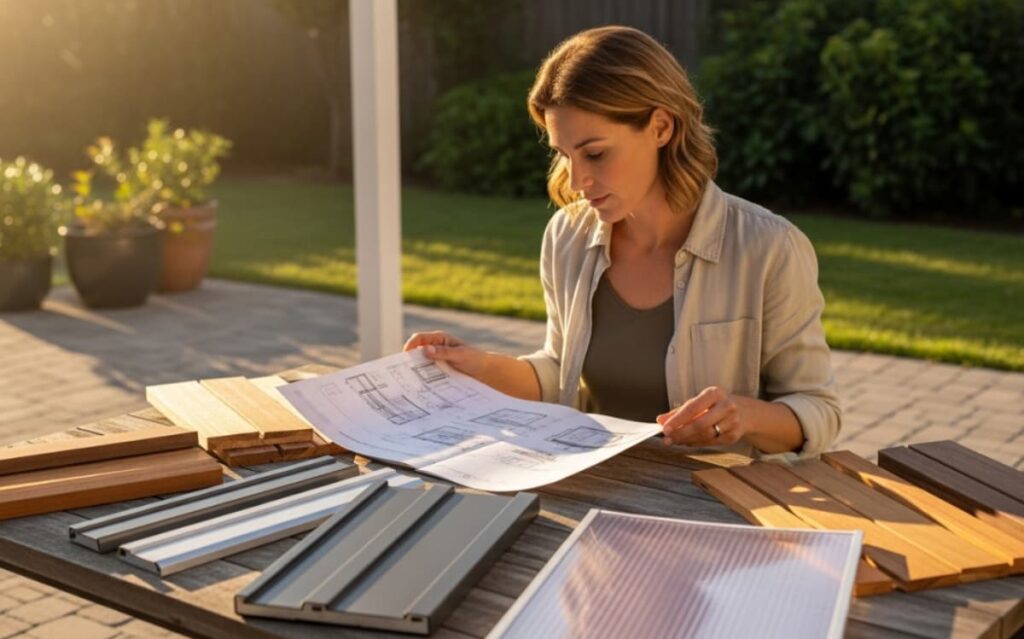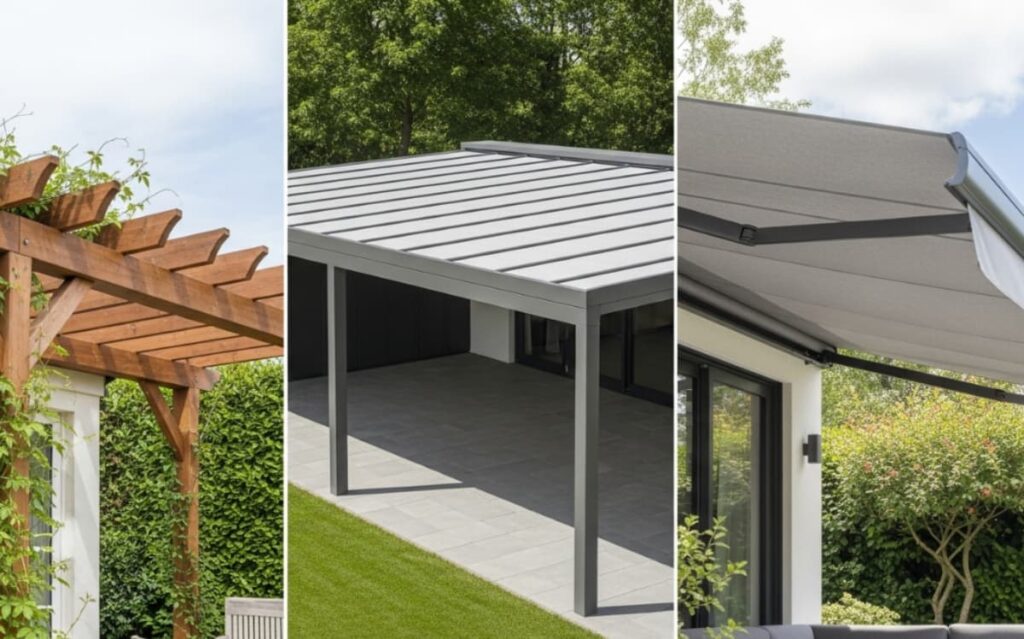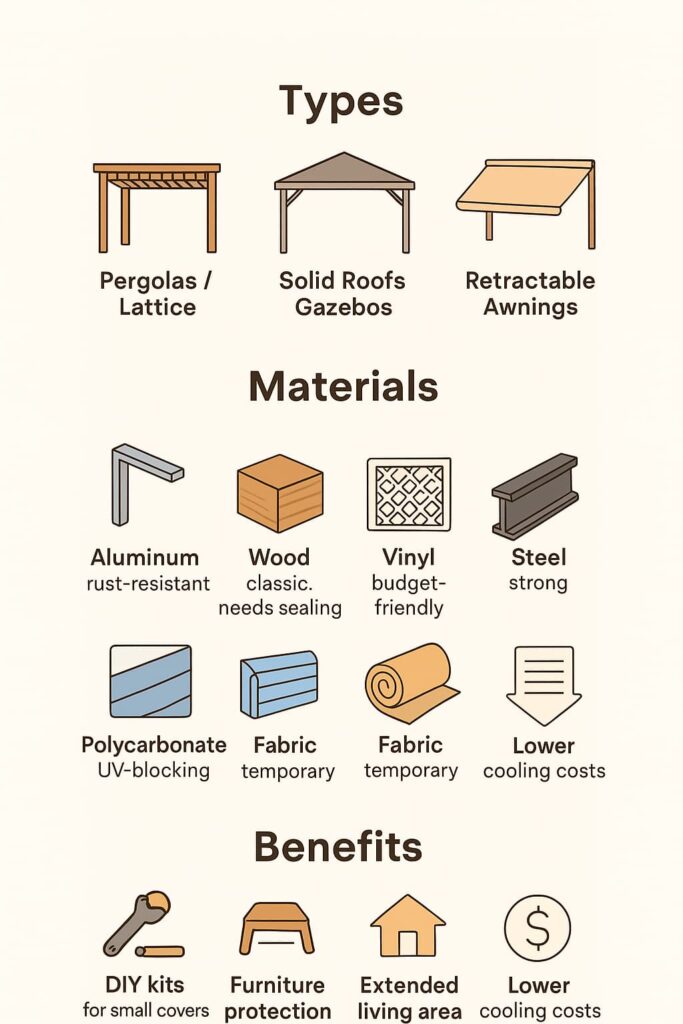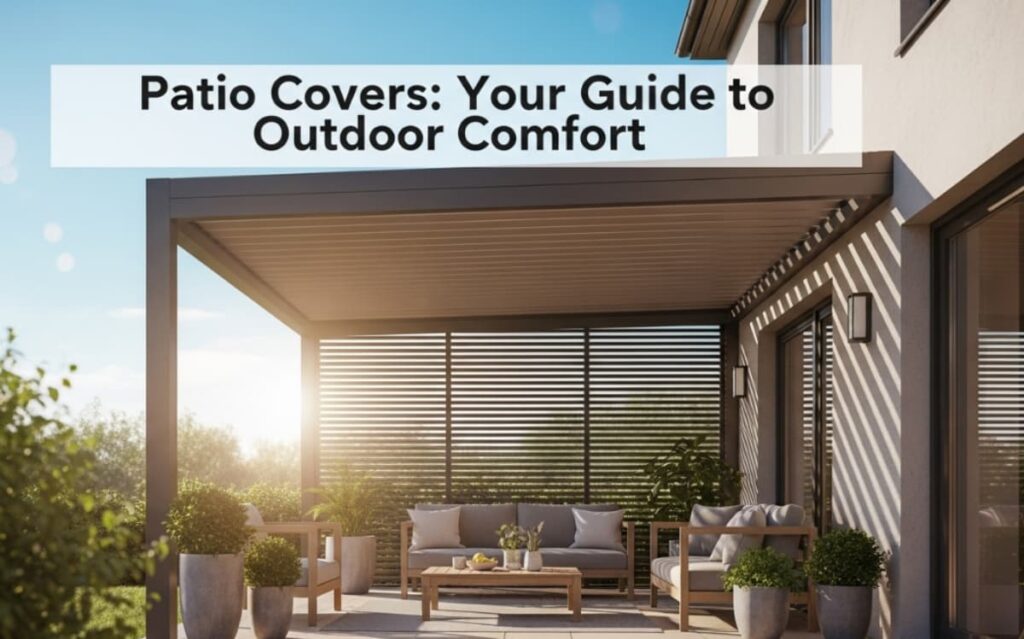Discover the right patio cover for your home. Our guide covers types, materials, benefits, and costs to help you create the perfect outdoor space.
A patio cover is a roof for your patio that makes shade and keeps the weather off your head. These structures come in many varieties and are made of various materials to fit just about any home and what you need.
From a simple fabric or awning to a beautiful wooden pergola, a patio cover can give you more living space, protect your outdoor furniture and even add value to your house. If you want to use your patio in general more, a cover is a good way to go.
Continue reading to get a better idea of how ideal you ought to get tooled up for your patio covers.
Key Takeaways
- Enjoy Your Patio More: A patio cover protects your outdoor room from the heat of the sun and rain that comes with certain areas in the fall months. This makes it a more comfortable area for you to relax or have fun with friends and family on week nights and weekends.
- Materials Make a Difference: The material you decide on, like wood sandalwood, aluminum sandalwood or vinyl isolation, affects what your cover looks like, how good it is for longevity and how much care it will need. Each one has its own pros and cons.
- Approaching Your 4.5×7 M Patio Cover in Need of Assembly: You can assemble some simple patio cover kits yourself. But for larger or more complicated structures, it is often best to employ the services of a professional installer; that way you can be sure that it will be safe and durable.
Patio Covers Are Not Just for Roofing

At our company, Lapis Patios, we understand that a good patio cover is more than just a roof. It’s another part of your house that transforms your patio into a more usable, comfortable place, however poor the weather. A patio cover resolves common problems which tend to make a patio a difficult living space.
Rain showers will destroy the original plan, and everyone has to retreat to its interior
On a bright day, an unsheltered patio can get too sizzling to spend time on it. The sun also changes and damages your outdoor furniture after a while.
A good patio cover will end these problems, by providing shade for you to relax in, yet letting you stay dry if it rains.
More and more people want outdoor spaces where they can live and play. That means more people are forking cash on things such as outdoor kitchen equipment, fire pits shaded with trellis tops reminiscent of cocktail umbrellas and (most of all) cozy seating.
A patio cover is also fundamental to creating a truly great outdoor living space. It means the area is free from inclement weather and always ready for use.
Covered Patio Ideas for Rain and Weather Protection
A prospective purchaser of a cover for the patio has several sorts to select from. Each one gives a different appearance and offers a different degree of protection. Knowing what’s available can guide you in making the best decision for your home patio installation.
Adding a Roof to a Patio for Weather Protection vs. Style
While the options above are best for rain, some covers are designed more for style and providing partial shade rather than full weather protection.
- Pergolas: These have a roof with open slats that creates partial shade. Pergolas look great and add style to your yard but don’t offer much rain protection. [1]
- Lattice Covers: These have a crisscross design that filters the sunlight. They give you a nice mix of sun and shade but are not designed to block rain.
Patio Cover Options for Rain
These structures are specifically designed to offer excellent protection from the rain, allowing you to use your outdoor space even during wet weather.
- Solid Covers: These have a solid roof that gives you full shade and keeps you dry in the rain. They make your patio a true all-weather space but can block sunlight from getting into your house.
- Gazebos and Covered Porches: These are more like real rooms and give you full coverage. They look beautiful and offer great protection but cost more and are harder to build.
- Awnings and Canopies: These are often made of fabric and can sometimes be pulled back or retracted. They give you the freedom to choose when you want shade, but they can require more cleaning and care. [2]
Choosing the Best Material for Patio Cover

Choosing the material for your patio cover is a major decision. It affects the appearance, strength and needs as far as care of the cover. Choose a material that looks good with your house and can stand your local weather.
This view gives you a whole new way of looking at patio covers. What to expect:
- Aluminum: This metal is strong and very easy to care for because it does not rust. It comes in many colors but can get dents from things like heavy hail.
- Wood: Wood gives a warm, natural look that many people love. It is strong, but it needs to be stained or sealed every few years to protect it from weather and rot.
- Vinyl: Vinyl is a good budget-friendly choice that is easy to install and clean. It is not as strong as wood or metal and can sometimes bend or fade in very hot or sunny places.
- Steel: For amazing strength, steel is a top choice, especially if you get heavy snow or wind. It needs a special coating to stop rust and is often heavier and costs more.
- Polycarbonate: These are clear or tinted plastic panels that block UV rays and rain but let light through. They are strong, but some cheaper plastics can turn yellow after a few years in the sun.
- Fabric: Fabric is used for awnings and shade sails and gives you many color options. It is a good choice if you want a flexible or temporary cover, but it will need to be replaced sooner than other materials.
Benefits of Installing A Patio Cover
Adding a patio cover to your home brings many good things. It does more than just give you shade; it makes your whole outdoor space better and gave. A proper cover can improve the way you live in your home every day.
Here are some incentives to catch the best patio cover.
- Get Shade and Stay Cool: A patio cover gives you a cool, shady spot to relax on hot, sunny days. It blocks the sun and makes your patio feel much cooler and more comfortable.
- More Room to Live: Your patio becomes another living space for your home. You can use it for family dinners, parties, or just as a quiet place to read a book outside.
- Protect Your Outdoor Furniture: A cover acts like a shield for your patio furniture. It protects your tables and chairs from sun and rain, which helps them last much longer.
- Save on Energy Bills: By shading the side of your house, a patio cover can help keep your home cooler inside. This means your air conditioner may not have to work as hard, which can save you money.
- Make Your Home Look Better: A beautiful patio cover adds style to your backyard and makes your whole property look nicer. It is a great feature that can also increase your home’s value.
Installation and Maintenance Suggestions

After you’ve chosen the type and material for your patio cover, the next step is installation and then ongoing maintenance. Good installation means your cover will be safe and last a long time. Simple maintenance will keep it looking and working its best.
How To Install A Patio Cover: A Step-by-Step Guide
While every patio cover kit or plan is a little different, the basic installation process usually follows these steps.
- Step 1: Plan and Prepare the Area. The first step is to measure your patio and decide exactly where the cover will go. You will need to mark the ground where the support posts will be placed according to your plan’s instructions.
- Step 2: Set the Support Posts. Next, you will dig holes for the support posts. The posts are then placed in the holes and secured with concrete to create a strong and stable foundation for the entire structure.
- Step 3: Attach the Ledger Board. A ledger board is a long, sturdy board that attaches directly to your house. This board will support the side of the patio cover that is against your home. It must be bolted securely into the house frame.
- Step 4: Build the Frame. Once the posts and ledger board are in place, you can install the main support beams and the rafters. The rafters are the smaller boards that run between the beams and the ledger board, creating the main frame for the roof.
- Step 5: Add the Roofing. The final step is to attach the roofing material to the rafters. This could be solid panels, lattice strips, or another type of covering, depending on the style of patio cover you chose.
Professional Installation or Do-It-Yourself?
If you have the right tools and feel comfortable doing it, you may be able to put in a simple patio cover. Larger covers made of materials like wood or steel are probably best done by a pro, however. Lapis Patios have over 10 years of experience, with every cover built safely and correctly for a result you can trust.
Regular Essential Maintenance
Taking care of your patio cover is easy and important for its longevity.
- Cleaning: Wash your cover every now and again to get rid of dirt, leaves and bird droppings. This helps it look nicer longer and prevents mold or rust from forming.
- Inspecting: Check your cover for loose screws, cracks or other signs of trouble once or twice a year. Addressing problems early can often save you from much bigger repairs later on.
- Lubricating: If your cover has parts that move, such as a retractable awning, add some oil or grease. This way it’ll open and close smoothly every time.
- Sealing/Staining: A wooden cover will need a new coat of sealer or stain applied every few years. This keeps the wood from splitting or rotting under the weather and sunlight.
Cost Factors in Various Types of Patio Covers
The cost of a patio cover can vary considerably depending on a number of factors. Knowing what affects price changes will help you plan your budget and choose something that suits your needs. The main factors determining its price are size, material and intricacy.
That is, a bigger cover costs more than a smaller one; a hardwood material like solid redwood or cedar costs more than any other type face. With a custom design it will cost more than a simple kit.
Here are different categories of general price ranges which you may use for reference.
- Canvas/Retractable Awnings: $3,500–$6,500+
- Aluminum Lattice Covers: $5,000–$8,500+
- Wooden Lattice Covers: $12,000–$18,000+
- Solid Wood or Insulated Aluminum Roofs: $7,500–$25,000+
Frequently Asked Questions About Patio Covers
Can I add lights or a ceiling fan to my new patio cover?
Yes, adding features like ceiling fans or lights is a great way to make your outdoor patio more comfortable and usable, especially at night or on warm days. It is very important to plan for this before the installation begins.
You must make sure the structure is engineered to hold the extra weight safely. We always recommend hiring a licensed electrician to run the wiring to ensure everything is done correctly and meets local safety codes for outdoor use.
Do I need a permit from my city to build a patio cover?
Whether you need a permit often depends on the size of your patio cover and your local city or county rules. Many areas require a building permit for any structure that is attached to your house or is over a certain size, like 120 square feet.
It is always best to call your local building department before you start your project. They can tell you exactly what you need to do to follow the rules and avoid any fines.
How well will a new patio cover hold up in strong winds or heavy snow?
A professionally installed patio cover is designed to handle the weather in your specific area. Materials like steel and aluminum are very strong and can withstand high winds. If you live somewhere with heavy snow, the cover must be built to support that extra weight.
Even with a strong cover, it is a good idea to secure your patio furniture and remove delicate items from your outdoor patio during extreme weather events.
Can a patio cover be attached to any part of my house?
Most patio covers are attached to a house along a flat, strong wall, known as a ledger board connection. It is often not possible or safe to attach a cover to areas like a chimney, a bay window, or an angled wall because these spots may not be strong enough to support the structure.
An experienced installer can inspect your home and find the safest and most secure place to attach your cover, ensuring it lasts for years.
How can I stop my outdoor furniture from getting moldy under a solid patio cover?
Even under a solid cover, moisture in the air can cause mildew on your outdoor furniture. To prevent this, make sure there is good airflow across your outdoor patio. Using high-quality, breathable furniture covers is also key.
A good chair cover or other patio furniture covers will protect your items from dust and dampness without trapping moisture inside. Always make sure your patio furniture is completely dry before using outdoor furniture covers, especially if it is near a fire pit where it may get damp.
Patio Cover: The Finishing Touch for Your Outdoor Oasis
A patio cover is a great choice for your home and how you live. It gives you shade and protection, turning your patio into a wonderful space where you can relax, eat, and make happy memories. The right cover keeps your outdoor furniture safe, makes your backyard a welcoming place for a quiet morning or a fun party, and can even make your home worth more.
We have talked about the different types of covers, the materials you can choose, and the many benefits they bring. Whether you love the classic look of wood or the easy care of aluminum, there is a perfect patio cover for your home and budget. With a little planning and a good installation, you can create a beautiful outdoor space that you will love for many years.
Ready to transform your backyard into a luxurious outdoor retreat? Contact Lapis Patios today for a free consultation and let our team of experts bring your vision to life with unmatched quality and professionalism
References
- https://www.thespruce.com/what-is-a-pergola-2131097
- https://en.wikipedia.org/wiki/Awning

